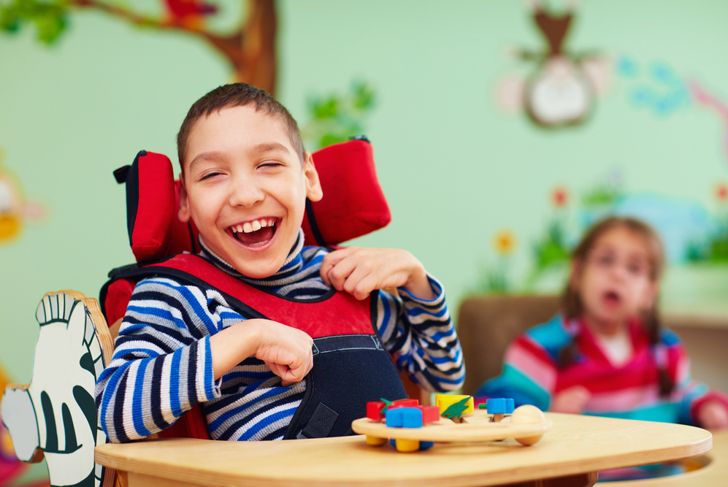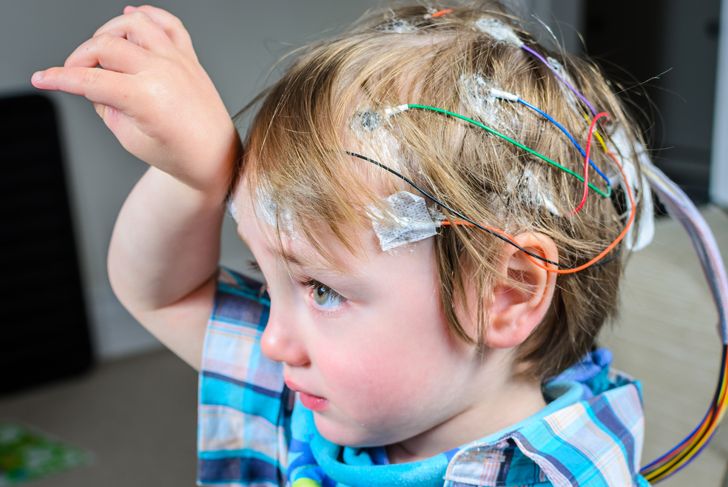Angelman Syndrome is a rare genetic disorder that severely affects the neurological system. It occurs when the UBE3A gene is abnormal or deleted altogether. Dr. Harry Angelman was the first to mention the disease. The English physician named the condition in the medical literature in 1965. The symptoms are not apparent at birth, but a diagnosis typically occurs between one and four years of age. There are many symptoms of Angelman syndrome; however, each person with the condition is unique in that he or she may not possess all of the symptoms. The broad spectrum of symptoms will vary from person to person.
Developmental Delays
Although every baby develops at his or her pace, apparent developmental delays are present in people with Angelman Syndrome. For example, the baby won’t be crawling or babbling by 12 months. The movement disorder may be noticeable as early as infancy at six months of age. Motor milestones are also slower including not walking until two or three years old. Babies may also experience tremors in their legs. As people with Angelman Syndrome get older, evident intellectual disabilities will emerge, and they will struggle with severe learning difficulties.
Eating and Digesting Problems
Besides mobility, your child may also have swallowing and feeding delays. Because of a reduced ability to suck, some infants struggle with eating. Luckily, the symptoms are not severe. Some babies experience tongue thrusting, which is characterized by protruding the tongue through the teeth during swallowing; all infants have this pattern at birth but lose the reflex around six months of age as they ingest solids. Even though the feeding issues are typically mild, children and adults with Angelman Syndrome can experience constipation or gastroesophageal reflux disorder (GERD). This constant reflux condition of backflow from the stomach through the esophagus to the mouth is irritating and uncomfortable.
Minimal or No Speech
Most kids with Angelman Syndrome have severe speech problems, which leads to a lack of communication almost altogether. They may speak a few words but do not develop the clear intellectual ability to communicate effectively. As children grow into adults, they might be able to respond to basic commands. Communication is primarily through gestures or command boards. Another reason why speech is troublesome for children with Angelman Syndrome is the physical aspect. Not only do they struggle with developmental disabilities, but, once again, they suffer from tongue thrusting. This notion lessens communication because the placement of the tongue limits the various sounds.
Ataxia – Difficulty Moving, Balancing, Walking
You will most likely notice limited mobility by the time your child is a year or so old. Your baby will continue to deal with ataxia as he or she grows. Not only will the child have abnormal balance, which directly leads to walking problems, but he or she will have jerky movements, too. These motions are due to the inability to control voluntary actions. Another prominent symptom of Angelman Syndrome is when children hold their arms up in such a manner that their wrists and elbows are bent in the air while moving around. Children with the condition tend to run and clap their hands repeatedly as well.
Continuous Laughter or Easily Excited
Laughter is the best medicine, and everyone loves a happy baby, but children with Angelman Syndrome tend to have a distinctive behavioral pattern, which is characterized by happiness. People with the condition will laugh and smile for extended periods of time for no apparent reason at all. Although it is not the worst symptom, the episodes may be inappropriate at times, primarily because they are unprovoked. Along with constant laughter, kids with Angelman Syndrome tend to get excited easily also. They are often hyperactive and hypermotoric. It is common for little children to move a lot in general, but those with this disorder do not sit still and are active explorers who are always moving. Maybe it is linked to being hyperactive, but people with Angelman Syndrome tend to have a decreased need for sleep. Abnormal wake and sleep cycles are frequent as well as sleep disturbances.
Microbrachycephaly – Small Head Size
Having a small head size can be a symptom of several different disorders. However, microbrachycephaly is a symptom of Angelman Syndrome. The nurse will note the circumference of the head just as he or she will measure height and weight. There is a particular size a baby’s head should be in regards to his or her age and body measurement. If it is too small, the brain is probably not growing correctly. Not only do children with Angelman Syndrome have microbrachycephaly, but the back of the head is also abnormally flat. This condition of the head is known as brachycephaly.
Hypopigmentation – Light Hair, Skin, Eyes
The lack of a natural shade of the skin, eyes, and hair because of limited amounts of a specific melanin pigment in the body is known as hypopigmentation. Children with Angelman Syndrome usually have light hair, skin, and eyes. The lack of melanin pigment can also lead to photophobia, which is an eye problem caused by the sensitivity to light. Another issue is involuntary, rapid eye movement known as nystagmus. Visual acuity is a decreased clarity of vision, which is also a symptom of hypopigmentation, and, therefore, Angelman Syndrome.
Seizures
Not all children with Angelman Syndrome will exhibit the same symptoms. For example, not all cases reflect epileptic seizures. These generally happen between the ages of one and five. Luckily, the presence of seizures tends to improve as the child reaches an adolescent. Anytime a child has a dizzy spell whether he or she loses consciousness or not, you should visit your family doctor immediately to discuss seeing a specialist. The sooner your child has a diagnosis, the better chance he or she will have at completing a safe and healthy treatment regime.
Stiff or Jerky Movements
Since infancy, the movement is one of the most notable symptoms of Angelman Syndrome. In severe cases, patients may not be able to walk until they are five or ten years old. After that, walking will still be slow and stiff. The jerky motions are quite evident. In fact, many children with the disorder cannot walk unaided at all. As mentioned, children may run around with their wrists and bent into the air or clap their hands repeatedly. These movements are obviously jerky and stiff. As patients get older, the joints stiffen even more, just as they do with healthier bodies, too. The inability to move develops even more.
Facial and Body Features
Angelman Syndrome patients may have hypotonia and hypertonia, which is diminished muscle tone of the trunk, but increased muscle tone of the arms and legs. They may suffer from hyperreflexia, an exaggerated reflex response. A less common facial feature is a widened mouth with widely-spaced teeth and a protruding tongue, which is called macrosomia. Another rarer set of symptoms of Angelman Syndrome is a pronounced lower jaw known mandibular prognathism and an abnormal protrusion of the cornea called keratoconus, which causes deep-set eyes. Crossed eyes have also been present in patients with the disorder. Scoliosis or the curvature of the spine may also become apparent as the child grows into an adolescent. Your family doctor will help you manage the challenges associated with Angelman Syndrome.

 Home
Home Health
Health Diet & Nutrition
Diet & Nutrition Living Well
Living Well More
More




















